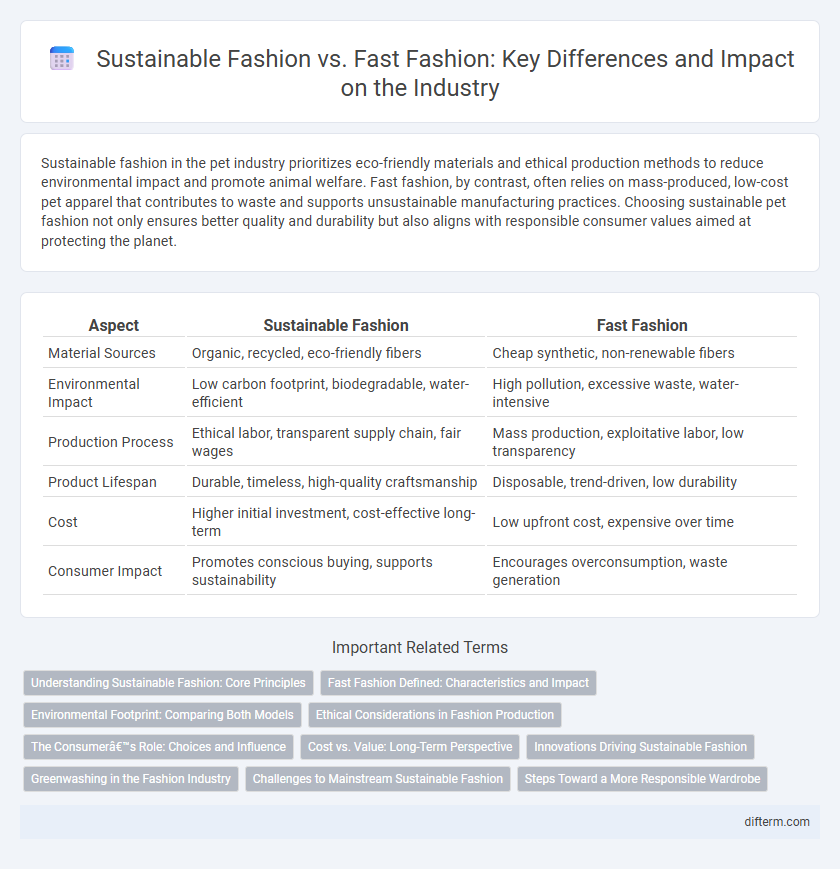Sustainable fashion in the pet industry prioritizes eco-friendly materials and ethical production methods to reduce environmental impact and promote animal welfare. Fast fashion, by contrast, often relies on mass-produced, low-cost pet apparel that contributes to waste and supports unsustainable manufacturing practices. Choosing sustainable pet fashion not only ensures better quality and durability but also aligns with responsible consumer values aimed at protecting the planet.
Table of Comparison
| Aspect | Sustainable Fashion | Fast Fashion |
|---|---|---|
| Material Sources | Organic, recycled, eco-friendly fibers | Cheap synthetic, non-renewable fibers |
| Environmental Impact | Low carbon footprint, biodegradable, water-efficient | High pollution, excessive waste, water-intensive |
| Production Process | Ethical labor, transparent supply chain, fair wages | Mass production, exploitative labor, low transparency |
| Product Lifespan | Durable, timeless, high-quality craftsmanship | Disposable, trend-driven, low durability |
| Cost | Higher initial investment, cost-effective long-term | Low upfront cost, expensive over time |
| Consumer Impact | Promotes conscious buying, supports sustainability | Encourages overconsumption, waste generation |
Understanding Sustainable Fashion: Core Principles
Sustainable fashion emphasizes eco-friendly materials, ethical labor practices, and reducing waste throughout the supply chain to minimize environmental impact. Key principles include using organic or recycled fabrics, promoting fair wages and safe working conditions, and designing for durability and recyclability. This approach contrasts with fast fashion's rapid production cycles and disposable culture, aiming instead for long-term ecological and social responsibility.
Fast Fashion Defined: Characteristics and Impact
Fast fashion is characterized by rapid production cycles, low-cost materials, and trendy designs that quickly reach consumers but often sacrifice quality and ethical standards. This industry model generates significant textile waste, contributes to environmental pollution, and relies heavily on exploitative labor practices in developing countries. The impact of fast fashion extends to increased carbon emissions and resource depletion, making it a major contributor to the global sustainability crisis.
Environmental Footprint: Comparing Both Models
Sustainable fashion significantly reduces environmental footprint by utilizing eco-friendly materials, minimizing waste, and promoting ethical production practices, which contrasts sharply with fast fashion's reliance on mass production, synthetic fabrics, and rapid turnover that contribute to high carbon emissions and textile pollution. Studies indicate that fast fashion generates approximately 10% of global carbon emissions and produces vast amounts of non-biodegradable waste annually, whereas sustainable brands employ circular economy principles to lower resource consumption and increase garment longevity. Choosing sustainable fashion supports biodiversity, reduces water usage by up to 70%, and mitigates microplastic pollution, making it a crucial model for environmentally responsible consumer habits.
Ethical Considerations in Fashion Production
Sustainable fashion emphasizes ethical considerations in fashion production by prioritizing fair labor practices, reduced environmental impact, and transparency in supply chains. Fast fashion often neglects these values, relying on exploitative labor and unsustainable materials to achieve rapid turnaround and low costs. Ethical production in fashion involves using eco-friendly materials, ensuring safe working conditions, and promoting social responsibility throughout the manufacturing process.
The Consumer’s Role: Choices and Influence
Consumers significantly impact the fashion industry's shift toward sustainability by choosing eco-friendly brands and demanding transparency in sourcing and production. Opting for sustainable fashion reduces environmental footprints, supports ethical labor practices, and encourages brands to prioritize durability over disposable trends. By prioritizing quality over quantity, consumers drive market changes that challenge the fast fashion model's rapid turnover and waste generation.
Cost vs. Value: Long-Term Perspective
Sustainable fashion emphasizes investment in high-quality materials and ethical production, resulting in durable garments that offer long-term value despite higher upfront costs. Fast fashion prioritizes low prices and rapid trends, leading to frequent purchases and increased waste, ultimately lowering overall value. Considering environmental impact and garment longevity, sustainable fashion presents a more cost-effective choice over time.
Innovations Driving Sustainable Fashion
Innovations driving sustainable fashion include the development of biodegradable fabrics, advanced recycling technologies, and the integration of circular economy principles in garment production. Brands are increasingly adopting digital tools such as 3D modeling and AI to minimize waste and optimize supply chain efficiency. These advancements enable the fashion industry to reduce its environmental impact while promoting ethical consumption.
Greenwashing in the Fashion Industry
Greenwashing in the fashion industry misleads consumers by promoting fast fashion brands as sustainable through deceptive marketing and vague environmental claims. Evidence shows many fast fashion companies use greenwashing tactics to mask unsustainable practices like excessive waste and unethical labor, undermining genuine sustainable fashion efforts. Transparency, verified certifications, and consumer education remain crucial to distinguishing truly eco-friendly brands from those engaging in greenwashing.
Challenges to Mainstream Sustainable Fashion
Challenges to mainstream sustainable fashion include the high production costs that limit affordability compared to fast fashion alternatives. Supply chain transparency remains complex, making it difficult for brands to verify ethical sourcing and environmental impact comprehensively. Consumer behavior also poses a barrier, as the convenience and low prices of fast fashion often outweigh the commitment to sustainability.
Steps Toward a More Responsible Wardrobe
Choosing sustainable fashion involves prioritizing eco-friendly materials, ethical manufacturing practices, and timeless designs that reduce waste, contrasting sharply with the rapid turnover and environmental impact of fast fashion. Investing in high-quality, durable pieces and supporting brands committed to transparency helps build a more responsible wardrobe. Recycling, upcycling, and mindful purchasing habits further minimize textile waste and promote a circular fashion economy.
sustainable fashion vs fast fashion Infographic

 difterm.com
difterm.com